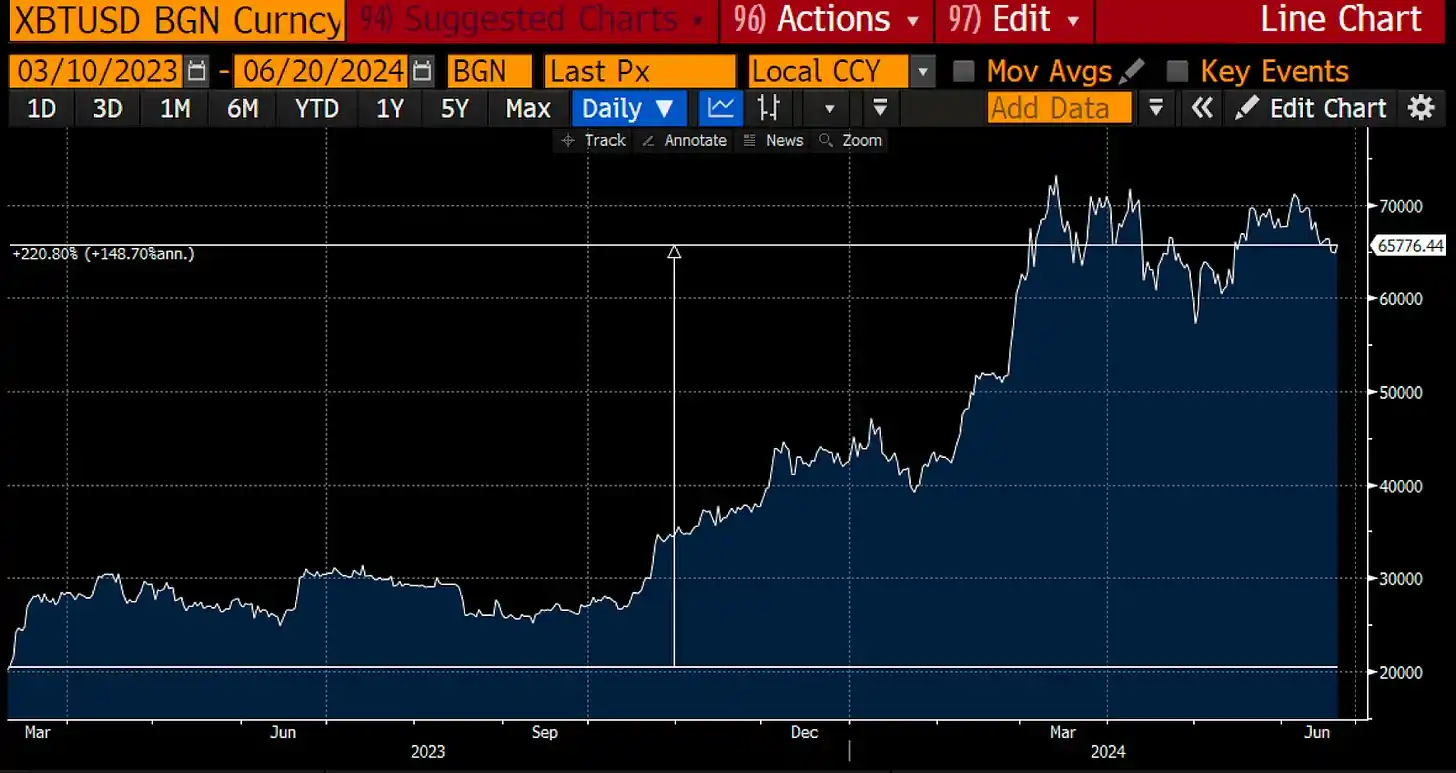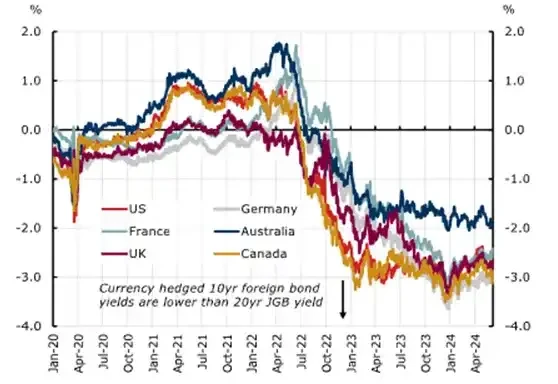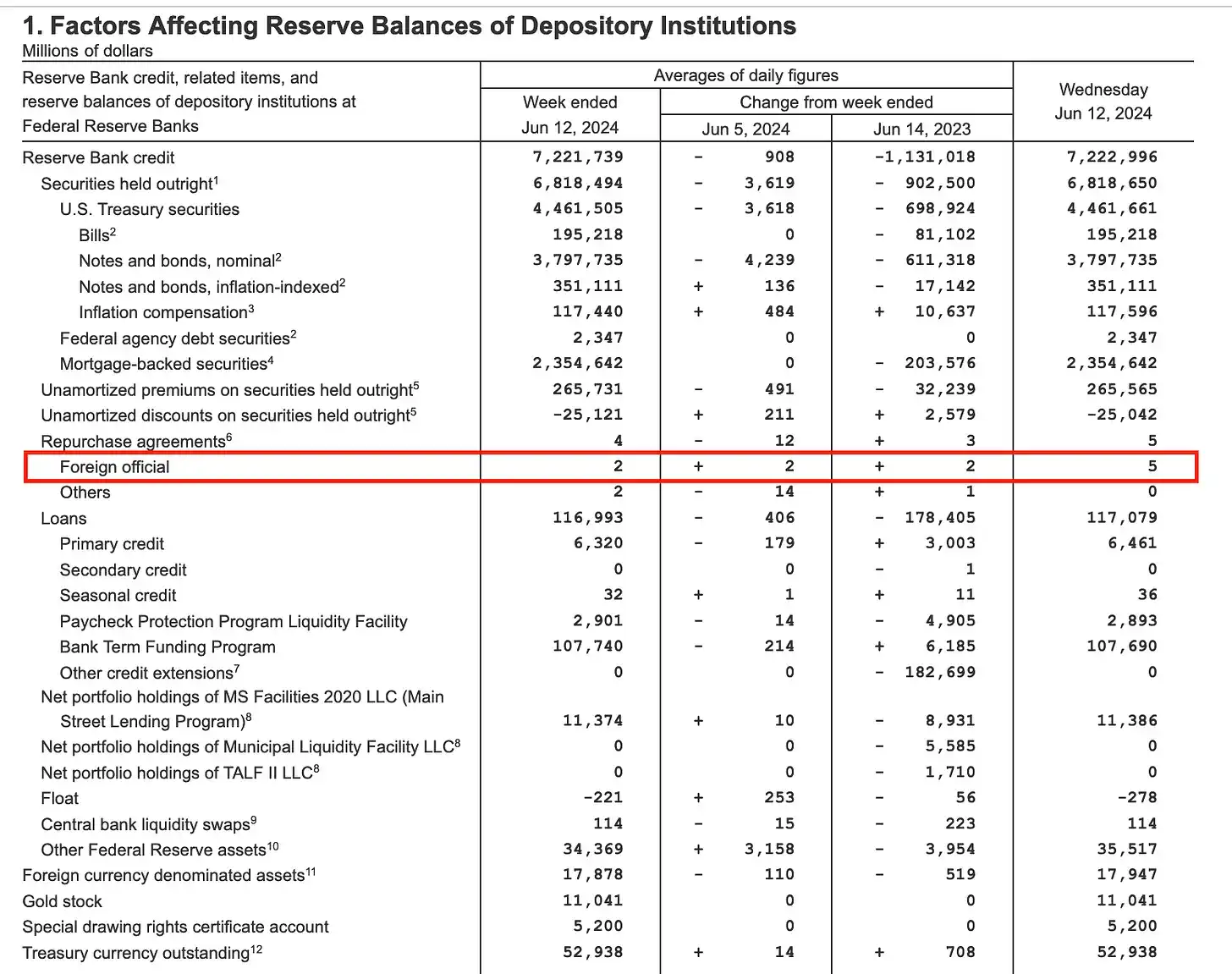原標題: 鹿田我內
原作者:阿瑟·海耶斯
原文翻譯:Ismay、BlockBeats
編按:在全球經濟動盪和金融市場波動的背景下,海耶斯深入探討了日本銀行體系在聯準會升息週期中面臨的挑戰以及美國財政和貨幣政策對全球市場的深刻影響。文章透過詳細分析農林中金銀行等日本商業銀行的外匯對沖美國國債投資策略,揭示了在利差擴大、外匯對沖成本上升的情況下這些銀行不得不拋售美國國債的原因。海耶斯進一步討論了FIMA回購機制的作用及其對美日金融關係的影響,並預測了該機制在維護市場穩定方面的關鍵作用。文章最終呼籲投資者在當前情況下抓住加密市場的投資機會。
我剛讀完金·斯坦利·羅賓遜三部曲的第一本書《紅色火星》,書中的人物之一、日本科學家愛弘子在談論情況時經常說“Shikata ganai”,意思是“無能為力”超出了火星殖民者的控制範圍。
當我為這篇短文想標題時,我就想到了這句話。本文將聚焦在成為美國治下和平貨幣政策受害者的日本銀行。這些銀行做了什麼?為了獲得不錯的日圓存款收益,他們進行了美元兌日圓套利交易。他們向國內年長的日本儲戶借錢,環顧日本各地,發現所有安全的政府和公司債券的收益率幾乎為零,因此他們得出結論,透過美國國債(UST)市場向美國治下的和平銀行借錢是更好的資本利用方式因為即使完全對沖匯率風險,這些債券也會提供更高的收益率。
但當美國因向公眾支付現金賄賂以安撫公眾接受被鎖在家裡並注射實驗藥物以對抗嬰兒潮而導致大規模通貨膨脹時,美聯儲(Fed)不得不採取行動。聯準會以 20 世紀 80 年代以來最快的速度升息。對於任何持有美國公債的人來說,結果都是個壞消息。從2021年到2023年,殖利率上升導致了自1812年戰爭以來最嚴重的債券反彈。
2023 年 3 月,第一筆銀行損失滲透到金融體系的底層。在不到兩週的時間裡,三大銀行倒閉,導緻聯準會對任何美國銀行或外國銀行美國分行資產負債表上的所有美國國債進行全面支持。正如預期的那樣,比特幣在救助宣布後的幾個月內飆升。
自2023年3月12日宣布紓困以來,比特幣已上漲超過200%。
為了支撐這大約$4 兆的紓困(我對美國銀行資產負債表上持有的國債和抵押貸款支持證券的總量的估計),聯準會在3 月宣布,使用貼現窗口不再是「死亡之吻”。 ”如果任何金融機構需要快速注入現金來填補因「安全」政府債券價格下跌而造成的資產負債表上的棘手漏洞,它應該立即使用這個視窗。當銀行體係不可避免地不得不透過貨幣貶值和損害人類勞動尊嚴來紓困時,我們該說什麼?什麼也做不了!
聯準會為美國金融機構做了正確的事,但在2020年至2021年全球融資激增期間也購買大量美國國債的外國人呢?哪個國家的銀行資產負債表最有可能被聯準會壓垮?當然,這是日本的銀行系統。
最新消息顯示,日本第五大銀行將出售價值$630億的外國債券,其中大部分是美國國債。
日本農林中金銀行將出售$630億美元的美國和歐洲債券
美國和歐洲利率上升,債券價格下跌。這降低了農林中金銀行過去購買的高價(低收益)外國債券的價值,導致其帳面損失擴大。
農林中金銀行是第一個投降並宣布必須出售債券的銀行。所有其他銀行都從事同樣的交易,我將在下面解釋。外交關係委員會讓我們了解日本商業銀行可能出售的巨額債券的規模。
根據國際貨幣基金組織的投資組合協調調查,2022 年日本商業銀行持有約 $8500 億美元的外國債券。其中包括近1010-4500億美元的美國債券和約10-750億美元的法國債券——這一數字遠遠超過其持有的其他歐元區大國發行的債券。
為什麼這很重要?因為耶倫不會允許這些債券在公開市場上出售並導致國債殖利率飆升。她將要求日本央行監管的日本央行(BOJ)購買這些債券。日本央行隨後將使用聯準會於 2020 年 3 月建立的外國和國際貨幣當局 (FIMA) 回購便利。
FIMA 回購設施的增加顯示全球貨幣市場美元流動性增加。你們都知道這對比特幣和加密貨幣意味著什麼……這就是為什麼我認為提醒讀者另一個無形的印鈔途徑很重要。直到讀完亞特蘭大聯邦儲備銀行一份題為「離岸美元與美國政策」的干巴巴的報告後,我才意識到耶倫是如何阻止這些債券進入公開市場的。
為什麼是現在?
聯準會在 2021 年底表示將於 2022 年 3 月開始升息,從那時起,美國國債(UST)開始崩潰。已經過去兩年多了,為什麼一家日本銀行在經歷了兩年的痛苦之後選擇現在承認損失?另一個奇怪的事實是,根據你應該聽聽的經濟學家的共識觀點:美國經濟正處於衰退的邊緣。因此,聯準會很可能會在幾次會議上降息。降息將推高債券價格。當所有聰明的經濟學家都告訴你救濟即將到來時,為什麼現在要賣出呢?
原因是農林中金銀行對美國國債的外匯對沖購買收益率從小幅正值變成了大幅負值。 2023年之前,美元和日圓之間的利差很小。隨後聯準會透過升息與日本央行分道揚鑣,而日本央行則堅持-0.1%。隨著利差擴大,對沖美國國債中的美元風險的成本超過了殖利率的上升。
這是它的工作原理。農林中金銀行是一家持有日圓存款的日本銀行。如果它想購買收益率較高的美國國債,就必須以美元支付。農林中金銀行今天將賣出日圓並買入美元來購買債券;這是在現貨市場上完成的。如果農林中金銀行只這樣做,而日圓在債券到期前升值,則農林中金銀行將美元賣回日圓時就會虧損。例如,您今天以 100 美元日圓的價格買入美元,明天以 99 美元日圓的價格賣出;美元貶值,日圓升值。因此,農林中金銀行通常會在三個月遠期市場上賣出美元並買入日圓來對沖這種風險。每三個月展期一次,直至債券到期。
通常,三個月遠期合約的流動性最強。這就是中國北方工業公司等銀行使用滾動三個月遠期合約來對沖 10 年期貨幣購買的原因。
隨著美元兌日圓利差擴大,由於聯準會政策利率高於日本央行利率,遠期點變成負值。例如,如果現貨美元日元為100,明年美元收益率比日元多1%,那麼美元日元一年期遠期價格應該在99左右。 100美元,然後把這100美元存起來賺1%利息,我一年就有101美元。美元日圓一年期遠期價格應該是多少才能抵銷這 1 美元的利息收入?約99美元日元,這是無套利原則。現在想像一下,我做這一切只是為了購買美國國債,其殖利率只比類似期限的日本公債 (JGB) 高 0.5%。我實際上在這筆交易中支付了0.5%的負收益率。如果是這樣的話,農林中金或任何其他銀行都不會進行這項交易。
回到圖表,隨著利差擴大,三個月遠期點變得如此之負,以至於對沖日元的美國國債外匯收益率低於直接購買以日元計價的日本國債。從 2022 年中期開始,您將看到美元的紅線位於 X 軸上的 0% 下方。請記住,購買以日圓計價的日本國債的日本銀行沒有貨幣風險,因此沒有理由支付對沖費用。進行此交易的唯一原因是外匯對沖後的收益率 > 0%。
北方工業的處境比FTX/Alameda的長期參與者還要糟糕。從市值角度來看,2020-2021 年可能購買的美國公債下降了 20% 至 30%。此外,外匯對沖成本已從微不足道增加到超過5%。即使中國北方工業公司相信聯準會會降息,0.25%的降息也不足以降低對沖成本或提振債券價格止血。因此,他們必須出售美國國債。
任何允許農林中金銀行質押美國國債以換取新美元的計畫都無法解決現金流問題。從現金流的角度來看,唯一能讓農林中金銀行恢復獲利的方法是大幅縮小聯準會和日本央行之間的政策利率差距。因此,在這種情況下,使用任何美聯儲計劃,例如允許外國銀行美國分行回購美國國債和抵押貸款支持證券以換取新印刷的美元的常設回購便利,都是無效的。
當我寫這篇文章時,我絞盡腦汁地思考任何其他可以使中國北方工業公司避免出售債券的財務手段。但如上所述,現有的計劃都是某種形式的貸款和互換。只要中國北方工業公司以任何形式持有這些債券,貨幣風險就仍然存在,就必須進行避險。只有在出售債券後,北方工業公司才能解除外匯對沖,對它來說是一筆巨大的成本。這就是為什麼我相信北方工業管理層已經探索了所有其他選擇,而出售債券是最後的手段。
我將解釋為什麼耶倫對這種情況不滿意,但現在,讓我們關閉聊天 GPT 並發揮我們的想像。有沒有一家日本公共機構可以從這些銀行購買債券並承擔美元利率風險而不用擔心破產?
叮咚
誰在那裡?
它是日本銀行。
救援機制
日本央行(BOJ)是少數可以使用 FIMA 回購機制的央行之一。它可以透過以下方式隱藏美國國債的價格發現:
日本央行溫和地建議任何需要出售美國國債的日本商業銀行將其直接出售到日本央行的資產負債表上,而不是在公開市場上,並以當前的最後交易價格結算,而不影響市場。想像一下,您可以以市場價格出售所有 FTT 代幣,因為 Caroline Allison 在那裡支援市場,並且可以提供任何必要規模的支援。顯然,這對 FTX 來說效果不佳,但她並不是擁有印鈔機的央行。她的印鈔機只能處理$100億的客戶資金,而日本銀行則處理無限制。
日本央行隨後利用 FIMA 回購機制將美國公債兌換成聯準會憑空印製的美元。
一,二,繫好鞋帶。這是規避自由市場的簡單方法。夥計,這是值得為之奮鬥的自由!
讓我們問幾個問題來了解這項政策的影響。
有人必須在這裡賠錢;由於利率上升導致的債券損失仍然存在。誰被吸進去了?
日本央行仍將確認以當前市場價格向日本央行出售債券的損失。日本央行現在承擔著未來美國國債到期的風險。如果這些債券的價格下跌,日本央行將出現未實現的損失。然而,這與日本央行目前其數兆日圓日本公債投資組合面臨的風險相同。日本央行是準政府實體,不會破產,也不受資本充足率要求的約束。它還沒有風險管理部門,當其風險價值(VAR)由於巨大的DV 01風險而上升時,該部門會強制減少頭寸。
只要FIMA回購機制存在,日本央行就可以每天展期回購並持有美國公債至到期。
美元供給如何增加?
回購協議要求聯準會向日本央行提供美元以換取美國國債。該貸款每天展期。聯準會透過印鈔機獲得這些美元。
我們可以每週監控注入系統的美元。該計劃的名稱是「回購協議——外國官員」。
如您所見,FIMA 儲存庫目前非常小。但拋售尚未開始,我認為耶倫和日本央行行長上田之間將會有一些有趣的電話。如果我是對的,這個數字還會增加。
為什麼要幫助別人?
美國人並不以同情外國人而聞名,尤其是那些不會說英語且看起來很奇怪的人。外表是相對的,但對於那些生活在天橋州、曬黑的、揮舞著南方邦聯旗幟的鄉下人來說,日本人看起來就不對勁。你知道嗎?這些粗俗的人將在今年十一月決定誰是下一任皇帝。真是無言了。
儘管有潛在的排外情緒,耶倫仍願意伸出援手,因為如果沒有新的美元來吸收這些垃圾債券,所有日本大型銀行都會效仿農林中金銀行,出售其美國國債投資組合以緩解痛苦。這意味著價值 1TP10-4500 億美元的美國公債將迅速流入市場。這是不被允許的,因為收益率會飆升,使聯邦政府的融資變得非常昂貴。
這就是創建 FIMA 回購協議的原因,正如聯準會自己所說:
「在 2020 年 3 月的『現金熱潮』期間,各國央行同時出售美國國債,並將所得資金存放在紐約聯邦儲備銀行的隔夜回購協議中。作為回應,聯準會於 3 月底提出,以紐約聯邦儲備銀行託管的美國國債作為抵押品,向各國央行提供隔夜貸款,利率高於私人回購利率。此類貸款將使央行能夠籌集現金,而無需在已經緊張的國債市場上強制出售。
還記得 2023 年 9 月至 10 月嗎?在那兩個月裡,公債殖利率曲線變陡,導致標普500指數下跌20%,10年期和30年期公債殖利率超過5%。作為回應,耶倫將大部分債務發行轉向短期國債,以抽乾聯準會逆回購計畫中的現金。這提振了市場,從11月1日開始,包括加密貨幣在內的所有風險資產都開始上漲。
我非常有信心,在選舉年,當她的老闆面臨被「橙人」犯罪之手擊敗的威脅時,耶倫將履行她的民主職責,確保收益率保持在低水平,以避免金融市場災難。在這種情況下,耶倫需要做的就是給上田打電話,指示他不要允許日本央行在公開市場上出售美國國債,而是利用FIMA回購機制來吸收供應。
交易策略
每個人都在密切關注聯準會何時最終開始降息。然而,美元兌日圓利差為+5.5%,即550個基點,相當於降息22次(假設聯準會每次會議降息0.25%)。未來十二個月內一次、兩次、三次或四次降息不會顯著縮小這個差異。此外,日本央行也沒有表現出提高政策利率的意願。日本央行最多可能會減少公開市場購債的步伐。日本商業銀行必須出售外匯對沖的美國國債投資組合的原因也沒有解決。
這就是為什麼我相信從目前賺取 20-30% 收益率的 Ethena 抵押美元 (sUSDe) 向加密風險資產的轉變將會加速。鑑於這項消息,日本央行別無選擇,只能退出美國國債市場。正如我所提到的,在選舉年,執政的民主黨最不需要的就是美國國債收益率大幅上漲,因為這將影響中位選民最關心的主要金融問題,即抵押貸款利率、信用卡和汽車貸款利率。如果國債殖利率上升,這些利率都會上升。
這正是創建 FIMA 回購工具的原因。現在所需要的就是耶倫堅持讓日本央行使用它。
就在許多人開始懷疑下一次美元流動性衝擊將來自何處時,日本銀行系統向加密貨幣投資者交付了由摺紙起重機製成的全新美元。這只是加密貨幣牛市的另一個支柱。為了維持目前以美元為基礎的美國治下骯髒的金融體系,美元供應必須增加。
和我一起說“Shikata ga nai”併購買蘸醬!
本文源自網路:Arthur Hayes:日本銀行拋售美國國債提振新的加密貨幣多頭市
近幾個月來,高估值、低初始流通量的代幣受歡迎一直是加密社群討論的話題。這是因為人們擔心這種市場結構在代幣生成事件(TGE)之後幾乎沒有為交易者留下可持續的上漲空間。 – 這是幣安研究院文章的開場白:低流通量高FDV代幣盛行,市場為何發展到這個地步?幣安研究院本週發布。似乎一時之間,高FDV、低流通量代幣盛行的原因和討論成為了加密貨幣媒體的頭條新聞,並被社區成員的熱門話題頻繁提及。 5月20日,幣安宣布將主導...










